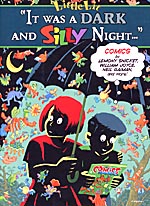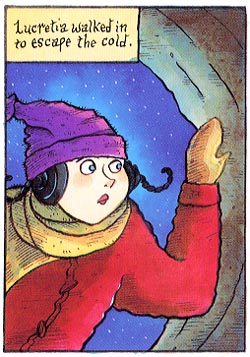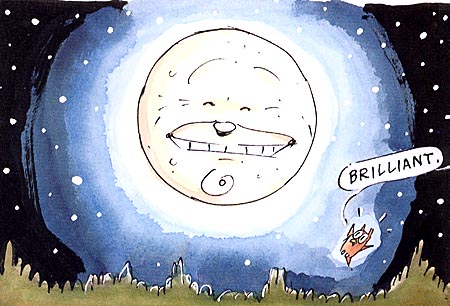 Edited by Art Spiegelman and Françoise Mouly
Edited by Art Spiegelman and Françoise Mouly
48 pages, color
Published by HarperCollins
There’s a stronger relationship between illustrated children’s books and comics than most people consciously realize. Both of them involve a series of images that, coupled with text, tell a story. The only real structural difference is that children’s books usually employ narration boxes instead of word balloons, and comics use panels much more often than children’s books. Still, the overlap between the two is pretty strong, and maybe that’s what Art Spiegelman and Françoise Mouly had in mind when they invented their Little Lit series, with children’s books and comics creators coming together to form an anthology of stories for both children and adults.
 The third book in the series, all the stories here are connected through the opening line of “It was a dark and silly night.” Perhaps the strongest story in the book following that opening is courtesy best-selling author Lemony Snicket (A Series of Unfortunate Events) and artist Richard Sala. Snicket and Sala spin a story of Yetis, snowstorms, and tree bark soup. What makes the story is how Snicket reverses the fortunes of his protagonist and the yeti that she’s tracking. It’s a clever twist of fortune that puts the reader on both sides of the story, and adults will really appreciate the recursive loop that sneaks up on you without warning.
The third book in the series, all the stories here are connected through the opening line of “It was a dark and silly night.” Perhaps the strongest story in the book following that opening is courtesy best-selling author Lemony Snicket (A Series of Unfortunate Events) and artist Richard Sala. Snicket and Sala spin a story of Yetis, snowstorms, and tree bark soup. What makes the story is how Snicket reverses the fortunes of his protagonist and the yeti that she’s tracking. It’s a clever twist of fortune that puts the reader on both sides of the story, and adults will really appreciate the recursive loop that sneaks up on you without warning.
Snicket and Sala’s entry is not the only strong story in the book, mind you. Dutch comic legend Joost Swarte’s story of a key dropped through a sewer grate and the problems that follow is both childlike and unnerving at the same time, if that’s possible. With detached body parts and plunges off cliffs all drawn in Swarte’s angular arthouse style, it’s visually the most distinctive story in the book while still being very accessible to children. The same is true for Neil Gaiman and Gahan Wilson’s story, which is probably the most like a children’s picture book in actual plot, as kids trying to find a place to play in piece invade a graveyard. Wilson’s eerie art might startle young readers at first, but his pop-eyed characters will no doubt quickly grow on them. The other real gem in the book is from Patrick McDonnell (Mutts), whose simple story about the moon being afraid to rise is nothing short of adorable, with gorgeous watercolor art to illuminate every panel of the story.
There are a couple of short activities for younger readers that will no doubt provide a lot of entertainment. Tony Millionaire’s scrambled panels that need to be restored to order is both attractive and a fun way to get younger readers’s brains moving. R. Sikoryak resurrects Mad Libs in a story where you get to fill in your own nouns and verbs for a different story every time through the page. Barbara McClintlock’s two paintings of bears frolicking during a picnic will challenge readers to find the differences between the two even as they enjoy her classically-styled art. Last but not least, Martin Handford shows that since creating the Where’s Waldo? books that he can still draw wonderfully complex crowd scenes, challenging the readers to find all the characters from the table of contents hidden in the drawings created for the book’s endpapers.

In the end, there are surprisingly few misfires. Carlos Nine’s story lacks any real punch or hook for the reader, despite some intriguing art that reminds me a lot of famed cover artists Jeffrey Jones. William Joyce’s story is more interesting in concept than execution as well, but the art is so vastly entertaining that it’s easy to lose yourself in its delights. The plusses far outweigh the minuses, though, and it’s hard to imagine anyone being less than thoroughly enchanted by It was a Dark and Silly Night…. If Spiegelman and Mouly can keep pulling together contents this strong, I for one will welcome years of Little Lit to come.
Purchase Links:
